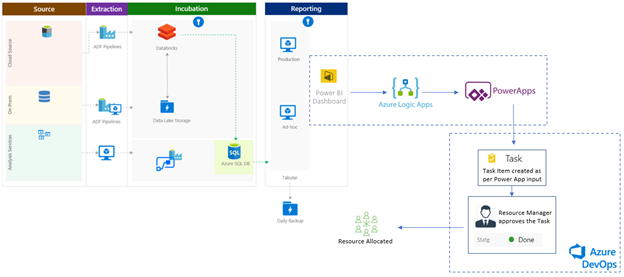
Business Case:
Our client, a Fortune 500 technology company, has a product and services team that provides support to customers around the world. Every few years, our client reassesses their organizational structure to identify gaps and resource management issues. During this cycle, our client found many business activities where support team members were underutilized.
In partnering with us, our client was looking for a solution that enables them to visualize and analyze resource utilization across their entire customer support team. The solution needed to identify underutilized resources and connect them to customer support opportunities.
Key Challenges:
•
Visualize resource utilization data from multiple sources
•
Automatically track resource allocation requests
•
Proactively connect underutilized support resources to service opportunities
Our Solution:
We developed a Power BI report and Power App that enable our client to view all support resource data and easily connect resources with service opportunities. We leveraged the capabilities of Azure Data Factory (ADF), Azure Databricks (ADB), and Azure SQL Database to create a reliable, scalable, and cost-effective solution.
 |
| Figure 1: Solution Architecture |
Our solution pulls data from our client’s existing “blocked services” system, an automated database of all “at-risk” and “blocked” support opportunities. At minimal opex, we can aggregate data from multiple sources using ADF pipelines, ADB, and Azure SQL Database. We track the engagement hours of support team members across the world. Our solution’s Power BI dashboards display resource utilization data in real time, enabling users to understand which resources are being under or over-utilized.
To manage support gaps, we developed a Power App where managers can connect resources to service opportunities by clicking the app link provided in the dashboard. Azure Logic Apps automatically populates relevant data in the app interface.
Once the manager sends the support request, the app creates an Azure DevOps work item assigned to the relevant team member. The DevOps item is auto-populated with all information input into the Power App to ensure the team member and manager can access identical information. To mark the completion of the request, the manager simply needs to update the work item status to Done.
Business Outcomes:
Our end-to-end Power Platform solution provides our client’s support team with real-time data on resource utilization. Our solution connects underutilized team member resources to service opportunities with high business value. Managers can gain insight into opportunity areas by analyzing the impact of resource allocation within our Power BI dashboard.
The Power BI resource utilization dashboards offer detailed information and insights on resource allocation so managers can identify underutilized resources at a granular level. Our solution offers massive load capacity, pulling data from multiple sources across the globe, without business interruption. For managers, analyzing resource allocation and assigning support requests is as simple as opening a Power BI report and clicking a link. Support team members can access all relevant information about the service opportunity assigned to them via Azure DevOps.
We ensured the page load time (PLT) across all report pages was under our company-standard threshold of 10 seconds. Through continuous optimizations, we reduced the time to 6-8 seconds, enabling decision makers quicker access to key insights. Our solution was initially developed for one area within our client’s organization. After its success, our client requested we expand the solution across the entire customer support team.
By enabling our client to effectively manage and analyze resource allocation, we cut down on costs and save time. The client can act quickly on important service opportunities, increasing customer loyalty.
Highlights:
• Developed a Power BI report and Power App that enables support managers to analyze resource allocation and close service gaps
• Enabled real-time data analysis from various data sources with a page load time (PLT) of 6-8 seconds
•
Reduced manual efforts by managers through a support request app that auto-populates service request data
• Reduced manual efforts by support team members through a solution architecture that auto-populates customized Azure DevOps work items
